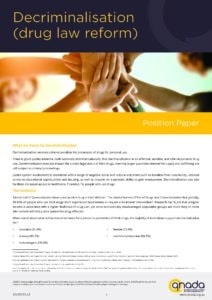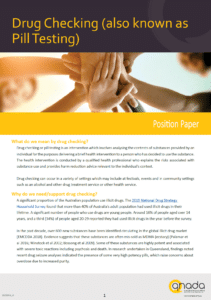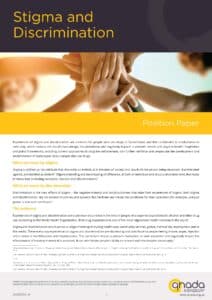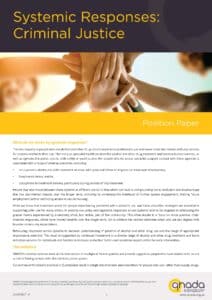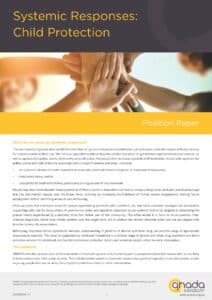Our policy positions
Decriminalisation (drug law reform)
QNADA’s policy position:
- It is clear there is a significant majority of Australians who support the removal of criminal penalties for personal use and possession (decriminalisation) of all drugs.
- People who use drugs are members of our communities and most do not experience problems that require treatment. Where people do need support, health-based responses (treatment and harm reduction) are the most effective.
- Law enforcement strategies that seek to deter people from using drugs are largely ineffective.
- Decriminalisation is a prudent strategy to increase opportunities for people to access treatment when they need it, increase community wellbeing and make savings to the Queensland budget.
- Implementation of the reform options outlined in the Qld Productivity Commission’s report on Imprisonment and
Recidivism will contribute to system improvement and should be implemented as a matter of priority.
Please click on the image below to read the full paper.
Drug Checking
QNADA’s policy position:
- Drug checking should be implemented immediately in Queensland.
- Evidence shows positive public health benefits for drug checking.
- Drug checking is consistent with the national drug policy framework of harm minimisation.
- Drug checking services have the potential to reduce drug related harms and save lives.
Please click on the image below to read the full paper.
Effective Responses to Drug Use
QNADA’s policy position:
- distinguish between problematic and non problematic use because a clear understanding of the different approaches required supports effective public policy
- are evidence informed, flexible, realistic, culturally responsive, and match individual needs
- are based on population level data (eg QDASPM, National Drug Strategy Household Survey) and community and expert input
- contain the appropriate mix of approaches that vary in intensity and are resourced according to need
- are readily available to all people who use alcohol and other drugs, regardless of their pattern of use.
Please click on the image below to read the full paper.
Stigma and Discrimination
QNADA’s policy position:
- The adoption of person first language across the health, justice and community services sector in Queensland will reduce the prevalence of attitudes that stigmatise people who use drugs.
- People with lived and living experience must be engaged at all stages of legislative, policy and service design and planning, in a manner consistent with the best practice principles for service engagement outlined in Stretch2Engage.
- Careful and credible reporting by the Queensland media of AOD issues will assist in reducing stigma and promoting help seeking behavior, in line with the established Mindframe guidelines.
- Implementation of the options for reform outlined in Don’t Judge, And Listen, as well as Changing Attitudes, Changing Lives will contribute positively to overall system improvement.
- The removal of criminal penalties for possession (decriminalisation) is an effective way to reduce the systemic harms associated with current legislative responses, and to increase opportunities for people to access treatment when they need it.
Please click on the image below to read the full paper.
Systemic Responses: Criminal Justice
QNADA’s policy position:
- Implementation of the options for reform outlined in Don’t judge and listen (2020) and Changing attitudes, changing lives (2018) will help to address the impact of stigma and discrimination on the design and implementation of the criminal justice system.
- Cross-system governance, which includes peak bodies and other key stakeholders is critical to drive structural improvements and provide a robust monitoring and evaluation function to improve system responses.
- Specific and targeted action must be taken to reduce the number of women and girls incarcerated for drugs possession.
- It is critical that there is a continued focus on improving the availability, accessibility and acceptability of the full spectrum of voluntary, confidential, alcohol and other drug treatment and harm reduction services while people are on remand, incarcerated or post-release. This includes access to Opioid Substitution Therapy, Needle and Syringe Programs, and Hepatitis C treatment in accordance with commitments in the Queensland Corrective Services Drug and Alcohol Strategy 2020-2025.
- Correctional centres must be prioritised in efforts to achieve the elimination of Hepatitis C, as well as to reduce injection related injuries and the transmission of other blood borne viruses.
- Planning and commissioning of health services should be undertaken by Queensland Health to ensure equitable access to health services (as required by the Queensland Human Rights Act 2019).
Please click on the image below to read the full paper.
Systemic Responses: Young People and the Justice System
QNADA’s policy position:
- The minimum age of criminal responsibility must be raised to 14 years in line with established international standards.
- Bail support programs are an effective way to keep children and young people out of watchhouses and off remand and must be expanded to ensure they are readily available.
- Policy and legislative responses must focus on addressing the broader social factors which elevate the risk of a young person coming into contact with police or entering the youth justice system, including poverty, homelessness, family violence, and problematic substance use. This extends to acknowledging and addressing the impact of stigma and discrimination on the design and implementation of the system.
- Services for young people must be delivered in a way that prioritises choice, confidentiality, and consent. Investment is needed to improve the availability, accessibility, and acceptability of voluntary alcohol and other drug treatment services for children and young people. Additional resourcing and workforce/sector development is also required to expand programs for young people across the spectrum of treatment and harm reduction interventions, in developmentally appropriate ways.
- To enable effective multi-agency collaboration, police and other statutory entities need to understand that their statutory role means they are not well placed to provide case management support. An effective cross system response would recognise non-government service providers are better positioned to provide intensive case management and support and have the specialist skills to do so.
Please click on the image below to read the full paper.
Systemic Responses: Child Protection
QNADA’s policy position:
- Policy and legislative responses must focus on addressing the social, cultural and structural factors that elevate the risk of a family coming into contact with the child protection system, such as poverty, homelessness and family violence. This extends to acknowledging and addressing the impact of stigma and discrimination, and institutional racism on the design and implementation of the system.
- To be effective, services must be delivered in a way that prioritises choice, confidentiality, and consent. Continued investment is also needed to improve the availability, accessibility, and acceptability of voluntary alcohol and other drug treatment services including to ensure programs are child-focused and accessible to parents.
- Implementation of the principles in Our Way: A generational strategy for Aboriginal and Torres Strait Islander children and families will positively contribute to both system improvement and achieving the Closing the Gap targets. Aboriginal and Torres Strait Islander Community Controlled responses are critical in improving outcomes for children
and families. - To enable effective multi-agency collaboration, statutory entities like child safety need to understand that their legislative role means they are not well placed to provide case management support. An effective cross system response would recognise non-government service providers are better positioned to provide intensive case management and support and have the specialist skills to do so.
- Current approaches to data collation and reporting around alcohol and other drug use must be improved, including to ensure that it appropriately reflects a more nuanced understanding of patterns of use.
Please click on the image below to read the full paper.
